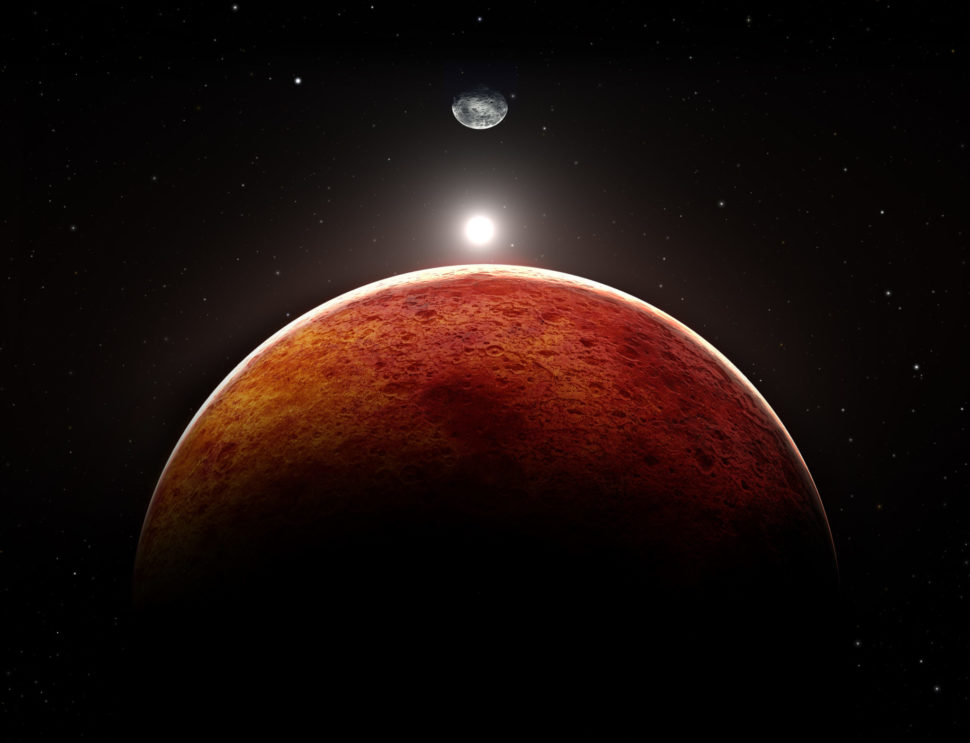Colonizing another planet is one of our most far-fetched yet sought-out goals. If, like us, you yearn for humanity to be a multi-planetary species, join us in encouraging those who are able to make that happen.
Two plans and one destination: SpaceX & NASA are the two main organizations with manned missions to Mars in mind. Who will be the first to get us to the Red Planet?
In 1971, two Soviet orbiters, Mars 2 and 3, successfully landed on Mars. Five years later, NASA followed with two other landers, Viking 1 and 2.
Several decades and probes later, data hasn’t yet revealed any signs of existing or even past Martian life.
The rover Opportunity, which spent over a decade on the Red Planet. In all that time of tirelessly searching for life, it found nothing.
From time to time, a tantalizing press release adds to the hype of a potential discovery on Mars, perpetuating hopes of some celestial neighbors.
However, more often than not, these hopes get dented pretty quickly.
The seasonal Martian flows? They’re most likely not liquid water but avalanches of sand and dust.
Mars methane? Not necessarily of biological origin, it could be from geological sources.
Lying on the outer edge of the solar system’s habitable zone, Mars seems to be utterly bereft of life. Yet, that doesn’t make it any less appealing for colonization.
You see, we may one day get to the Red Planet and sow the seeds of life there, which would be game-changing for both Mars and humanity.
In 2018, the race for a successful mission to Mars is officially on with different organizations and countries each having their own Mars agenda.
Let’s take a look at the two agencies who seem to be the most likely to get us there.
SpaceX “2024”: Musk’s Multiplanetary Dream
Elon Musk is selling us on a dream, and we’re so in!
Not only does SpaceX promise to get humans to Mars, it also has a project with an aggressive and tight timeline.
SpaceX plans to launch the first cargo mission to Mars in 2022. Then, if everything goes off without a hitch, it would follow up with a crewed mission in 2024.
The startup has been working hard for several years to develop hardware that is efficient, safe, and economical.
Above all, SpaceX has made rocket reusability its motto and strength.
In 2012, the Falcon 9 orbital rocket helped SpaceX become the first private company to ever reach the ISS. In the following five years, the Falcon 9 has made many journeys to space. Among these, the carrying of the Dragon capsule and different payload cargos to and from the ISS have given the startup a strong name in the astronomical field.
However, the Falcon 9 is only an entry level rocket for SpaceX.
With three nine-engine cores, Falcon Heavy is the most powerful operational rocket in the world today. If it weren’t for NASA’s Saturn V, which transported Apollo mission crews to the moon, Falcon Heavy would be the most powerful launch vehicle ever made.
On February 6, 2018, Falcon Heavy managed to shock the world by flying into space carrying a red Tesla Roadster and a dummy in a spacesuit, with David Bowie’s “Life on Mars” on loop.
Now, Starman and Musk’s Roadster are drifting through space. On their journey through space, they may get well beyond Mars and keep orbiting the Sun until possibly coming back to crash on Earth in millions of years.
But for his plan for a mission to Mars, Musk is betting on another transportation system, the Starship.
Read: SpaceX’s Starship to Make its First Flight by 2020
As it is designed as a single vehicle with a booster and a spaceship, the BFR could eventually replace the two other Falcon rockets as well as the Dragon spacecraft
Hours after the successful test launch of the Falcon Heavy, Musk revealed in a press conference that SpaceX engineering efforts would next focus mostly on the BFR.
Musk said that the aim now is to run the first full-scale test of BFR within three to four years.
Check the link above to learn more about the specifics of Elon Musk’s BFR Mars colonization plan. In short, however, Elon Musk plans to launch cargo missions to the Red Planet which will establish a functional space station by 2022.
NASA “2030s”: Against all Budgetary Odds
Nothing seems to bridle NASA’s imagination except federal policy-makers. So much so that the agency has announced last summer that it won’t be able to carry on with its mission to Mars plan due to budget constraints.
Read: Sorry, Mars Fans; NASA Can’t Afford the Trip
This isn’t the first time money has gotten in the way of NASA projects.
In 2010, after years of development, NASA abandoned the Constellation project that was supposed to get American astronauts back onto the moon.
NASA also had discontinued its Saturn V moon rocket, which made its last trip in 1973. The reasons given were that it was deemed too expensive and that they wanted to focus on the space shuttle instead.
Then, in 2011, the agency gave up on the space shuttle program and began relying on Russian launch vehicles to carry its astronauts and cargos to the ISS.
However, NASA hasn’t scrapped its Journey to Mars project altogether.
The agency still states its aim of sending human explorers to Mars in the 2030s. Before getting to that, NASA’s Mars plan would evolve through three distinct stages:
Earth Reliant (until the mid-2020s): This phase will be about accumulating knowledge about prolonged stays and continuing space research in the ISS, which will shut down in 2024.
Proving Ground (2018-2030): The next stage will see the moon serve as a testing ground with frequent trips to cislunar space for crews and hardware.
Earth Independent (2030s and beyond): This is the culmination of NASA’s mission to Mars plan. As human crews would get to Mars’ low-orbit, NASA astronauts would put to use descent and landing techniques as well as in-situ resources utilization methods and gears.
Beyond the transportation means of the SLS rocket and Orion, whose first flight has been rescheduled to late 2019, NASA has also been thinking about ways to provide enough energy to meet the needs of future spacefarers.
The Kilopower project aims at developing mini nuclear reactors that in addition to being transportable, would also operate autonomously and don’t depend on outside sources, such as solar.
The Martian Race is On
NASA and SpaceX are certainly the biggest players in the colonization of Mars, but they’re not the only contenders. Until recently, Mars One seemed like a potential upsetter, but its abrupt filing for bankruptcy put a swift end to their efforts. Amazon’s Blue Origin are the true silent outsider that’s behind the pack but certainly not out of the race.
All of these contenders certainly have the chance to be the first to put humans on Mars. However, with decade-long projection plans and billions of dollars of funding, it’s anyone’s guess who will be the first to make history.
In any case, it’s safe to say that the next ten years will see some significant advances in space exploration and competition. Who knows, maybe the company who will get us to Mars doesn’t exist yet. But, with the ever-increasing hype and funding around these projects, it’s certainly a time of wishful thinking.



















There is some news out of Asia, that China has a covert plan to beat the United States to Mars. Their Long March 5 could make the journey. It is said that China is focused on the Moon, but would love to leap frog over the US to become the first country to send humans to step on another planet.
Hi Rod, what’s your source?
The Long March 5 isn’t nearly powerful enough to mount a crewed mission to Mars. It can only take 8 metric tons to TLI (trans-lunar injection), that’s the mass of a relatively small capsule (like Orion). The Chinese have started development of a super-heavy launcher, the CZ-9 (aka Long March 9) which will be roughly equivalent to the Saturn V, which will enable Mars missions, although even then, likely requiring multiple launches and in-orbit docking or assembly. CZ-9 is expected to fly in the late 2020s, with a Moon landing sometime around 2032. Presumably, Mars could follow in the late 2030s.
If SpaceX succeeds in building their “BFR”, and gets funding (perhaps from NASA), it’s possible Americans could walk on Mars in the late 2020s.
Just to be clear – Mars One isn’t sending people anywhere off-planet. They have no hardware, no contracts to build crewed flight hardware, no real plans, and nowhere close to enough money to even start. The organizations with a chance at putting boots on Mars are NASA, SpaceX (likely with NASA funding for a BFR mission), or eventually, China. An outside dark horse might be Blue Origin, as Bezos has hinted at a “New Armstrong” rocket, and he has effectively unlimited money (he’s worth over $100 billion,).